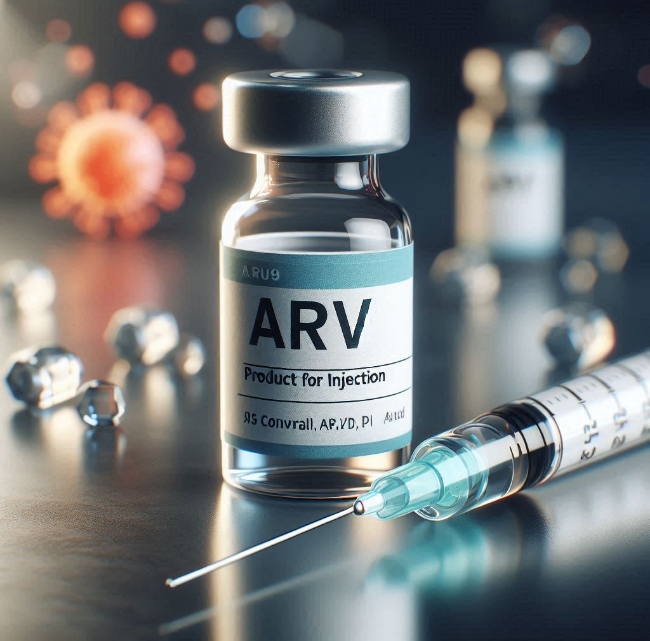Long-acting injectable antiretrovirals: a promising innovation for HIV prevention and treatment
- September 30, 2024
- Uncategorized
- By The Bureau
- Read in French

Introduction
Long-acting injectable ARVs are a major breakthrough in HIV prevention and treatment. They are used as pre-exposure prophylaxis for HIV-negative people, particularly those at high risk of contracting HIV, and as light therapy for people living with HIV with stable virological suppression on antiretroviral treatment.
By reducing the frequency of doses taken, this therapy helps to improve adherence, reduce the stigma associated with taking daily pills, and enhance the quality of life of people living with HIV. This article examines the current context, benefits, challenges, cost-effectiveness and prospects of long-acting ARVs in Africa, and provides recommendations.
Current context
Long-acting injectable antiretrovirals (ARVs) offer an alternative to daily oral therapy. These ARVs include cabotegravir (CAB-LA) and rilpivirine (RPV-LA).
Cabotegravir is an integrase inhibitor, an enzyme that HIV uses to insert its genetic material into human cells. By blocking this enzyme, cabotegravir prevents the virus from multiplying.
Rilpivirine is a non-nucleoside reverse transcriptase inhibitor (NNRTI), an enzyme needed to convert viral RNA into DNA. By inhibiting this enzyme, rilpivirine prevents the virus from replicating.
Approved by regulatory bodies such as the US Food and Drug Administration (FDA), the European Medicines Agency (EMA) and Health Canada, the combination of cabotegravir and rilpivirine (CAB-RPV) was introduced as a long-acting antiretroviral treatment option for HIV from 2021. It is administered as an intramuscular injection, which considerably reduces the burden of taking tablets on a daily basis. The results have demonstrated the efficacy of CAB-RPV in maintaining viral suppression in people with HIV. For example, the results of the ATLAS-2M showed that 94,3% of patients who received this combination every two months maintained an undetectable viral load.
Pre-exposure prophylaxis, or PrEP, is an effective strategy (anti-HIV drugs) for preventing HIV transmission, that HIV-negative people can use to reduce their risk of contracting the virus. For long-acting PrEP, cabotegravir is administered by intramuscular injection every two months. Studies show that CAB-LA is approximately 89% more effective than daily oral PrEP tablets (TDF/FTC) in preventing HIV infection. Another study, HPTN 083, showed a 66% reduction in HIV infections in men who have sex with men (MSM) and transgender women taking cabotegravir, compared with those taking oral tenofovir/emtricitabine (Truvada).
What are the benefits of long-acting ARVs?
These ARVs offer a number of benefits, such as:
- Improved adherence : they reduce the need to take medication every day, which helps to improve adherence, particularly in people who find it difficult to take pills every day.
- Reduced stigma: Fewer daily doses imply less risk of involuntary disclosure of HIV status.
- Fewer drug interactions: these ARVs have fewer drug interactions than some oral regimens, making them a safer option for people taking multiple medications.
- Greater confidentiality: the spaced dosing schedule allows for greater confidentiality and discretion in the management of HIV.
- Effectiveness: studies show that these treatments are as effective as oral ARVs after 48 weeks and over two years of follow-up.
What are the challenges in the use of long-acting ARVs?
These challenges are mainly related to administration requirements, cost, certain side-effects and regulatory and logistical hurdles.
These ARVs must be administered by healthcare professionals, which can be an obstacle in low-resource settings. In terms of costs, they can be higher than those of traditional oral treatments, thus limiting access to these ARVs. In addition, like any treatment, long-acting ARVs can have side effects, such as injection site reactions and other adverse events, but these vary from one individual to another. Finally, ensuring widespread availability and overcoming regulatory hurdles such as approval delays and intellectual property issues, among others, remain major challenges.
Cost-effectiveness
Although there a no precise figures available, studies have shown that long-acting ARVs can be cost-effective, particularly when the long-term benefits of improved adherence and reduced HIV transmission are factored in. A modelling study indicated that CAB-RPV LA could generate lifetime cost savings and improve quality-adjusted life years (QALYs) compared with daily oral treatment, although the initial costs of long-acting ARVs are higher. Injectable ARVs require fewer doses (for example, one injection every two months) than oral ARVs which must be taken daily, and therefore, improve adherence, leading to greater efficacy and reduction in the costs associated with health complications. This can reduce the costs associated with adherence and frequent medical visits. In addition, injectable ARVs can reduce the risk of drug resistance,ensuring a stable concentration of the drug in the body, potentially reducing the long-term costs associated with second-line treatment.
Who are the target people for long-acting PrEP?
The people targeted for long-acting pre-exposure prophylaxis (PrEP) are those at high risk of HIV infection, in particular men who have sex with men (MSM) and transgender women; (these groups are often the most exposed to the risk of HIV transmission); serodiscordant heterosexual couples (where one partner is HIV-positive and the other is HIV-negative); people who inject drugs (although the level of evidence is lower, this group remains an important target for PrEP); sex workers because of their increased exposure to the risk of HIV infection; and young people and adolescents at high risk, with a view to improving adherence and reducing the stigma associated with taking drugs on a daily basis.
Who is eligible for CAB-RPV dual therapy?
CAB-RPV dual therapy, a combination of cabotegravir (CAB) and rilpivirine (RPV), is generally intended for adults living with HIV who meet the following criteria:
- Be on stable antiretroviral treatment for at least 6 months.
- Have a viral load below 50 copies/mL.
- No current or previous resistance to the two molecules included in this dual therapy.
- Have a CD4 cell count above 200 CD4/mm.
What are the plans for these major innovations in Africa?
PEPFAR (President’s Emergency Plan for AIDS Relief) plays a crucial role in the implementation of long-acting injectable PrEP in sub-Saharan Africa, notably through funding and technical support for PrEP programmes, including those using long-acting cabotegravir, collaboration with organisations such as Unitaid and WHO to facilitate access to generic cabotegravir, to low-income countries, training for healthcare professionals on the administration of injectable PrEP and the management of side-effects, awareness-raising campaigns to inform at-risk populations about the benefits of injectable PrEP and encourage its use, to name but a few.
With regard to the dual CAB-RPV therapy (cabotegravir and rilpivirine) for HIV treatment, projects are underway to assess all aspects of this therapy in the quest for therapeutic solutions tailored to the specific needs of people living with HIV, and adolescents in particular. Examples include:
- The CABRILADO study, which aims to assess the feasibility and acceptability of long-acting injectable treatment with CAB-RPV in adolescents living with HIV in West and Central Africa. Participating countries include Senegal, Mali, Cameroon, Côte d’Ivoire and Burkina Faso.
- The phase 1/2 MOCHA clinical trial that assesses the efficacy and safety of dual CAB-RPV therapy in adolescents aged 12 to 17, with the aim of establishing whether this treatment can improve patient adherence and reduce treatment failures.
- The CARES study, a randomised trial which assesses the virological efficacy of the CAB-RPV combination injected every two months in an African population, despite a number of associated virological failure risk factors.
Prospects and recommendations
To maximise the benefits of long-acting ARVs for high-risk populations in particular, some conditions need to be met, namely:
- Equipment ofhealth systems with the capacity to store and distribute them effectively,
- Training of healthcare professionals in the administration ofinjections and the management of side-effects,
- Introduction of subsidy policies and financial aid to make these treatments affordable, especially in low-income countries,
- Negotiation of lower prices with manufacturers,
- Inform target populations about the benefits of long-acting ARVs to reduce hesitancy.
- Offer personalised support to help patients keep their medical appointments.
- Work in partnership with local organisations and health associations to reach more people.
- Train community members as peer educators and ARV counsellors, thus facilitating the dissemination of information and support to users.
- Set up surveillance systems to rapidly detect and manage cases of HIV resistance.
- Regularly evaluate the impact of initiatives with a view to adjusting strategies as appropriate.
Conclusion
Long-acting antiretroviral therapy offers a promising alternative to traditional HIV prevention and treatment regimens. By reducing the risk of HIV infection, increasing adherence, reducing stigma and improving the quality of life of people living with HIV, this therapy can play a crucial role in achieving global HIV prevention and treatment goals, both for prevention in HIV-negative people at high risk of contracting HIV and for maintaining viral suppression in stable HIV-positive people. To maximise the benefits of this innovative therapeutic approach, the commitment of global health institutions, governments, healthcare professionals and communities is essential.
By Rose Meku


